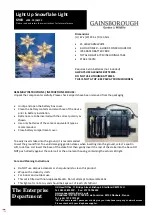
G
SAFETY WARNINGS
■
Safety Warnings
and
Precautions must be read
and understood before the instrument is used. They
must
be observed during use.
■
Do not
leave the instrument connected to the system under test when not in use.
■
Circuit connections and exposed metalwork of an installation or equipment under test
must not
be touched.
■
The instrument
must not
be operated or connected to any external system if it shows any visible signs of damage or if it has been stored for prolonged
periods in unfavourable conditions.
■
The instrument
must not
be operated or connected to any external system if the battery compartment or casing is open or any parts of the case
(including keypad, selector switch, display window, etc.) are missing.
■
The earth spikes, test leads and their terminations (including connections to the earthing system under test)
must not
be touched if an installation earth
fault can arise unless adequate precautions are taken.
■
The earth spikes, test leads and their terminations (including connections to the earthing system under test)
must not
be touched while the instrument
is switched on.
■
Special precautions
are necessary when operating in situations where ‘live’ earths may be encountered: isolation switches and fuses (not supplied with
this instrument) must be used.
■
Special precautions
are necessary when working near high tension systems (MV and HV): rubber gloves and shoes (not supplied with this instrument)
should be worn.
■
Special precautions
are necessary when working in wet conditions or in agricultural areas: observe the local safety standards and take all necessary
special precautions applicable to the particular location.
■
The instrument
must
be disconnected from the earthing system under test while batteries are being changed or the fuse replaced.
■
Replacement batteries and fuses
must
be of the correct type and rating.
2
Users of this equipment and/or their employers are reminded that National Health and Safety Legislation requires them to carry out valid risk assessments of
all electrical work so as to identify potential sources of electrical danger and risk of electrical injury such as inadvertent short circuits. Where the assessments
show that the risk is significant then the use of fused test leads may be appropriate.
NOTE
THE INSTRUMENT MUST ONLY BE USED BY SUITABLY TRAINED AND COMPETENT PERSONS.



































